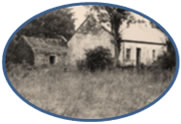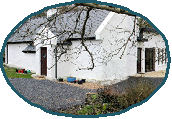HEATING
In refurbishing the cottage, the greatest change that we undertook was moving from a simple turf fire to a state of the art, remote-controlled solar and heat pump driven system.
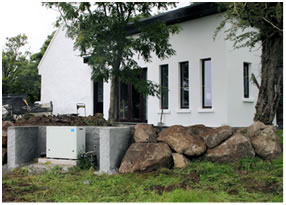 |
The Heat Pump itself sits under the deck next to the patio, sited to minimise the noise from the compressor. It's of Irish manufacture and is connected externally to 750m of piping buried 1.5m deep under the field in front of the cottage. The excavation work was enormous! |
 |
| Internally it is connected to seven individually controlled zones of coiled pipework set into the concrete of the floor. That concrete sits on 50mm of foam insulation and is also insulated from the outside walls of the cottage, so acts like an enormous storage radiator. This allows us to use off-peak electricity to power the compressor and store the heat in the floor. |
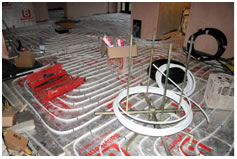 |
|
At peak efficiency, the compressor delivers 4kW of heat for every 1kW of electricity by operating like a refrigerator in reverse. The extra heat is taken from the soil beneath the field.
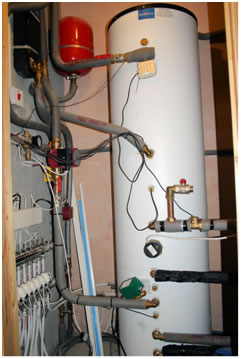 |
Hot water is provided by a 300 litre cylinder in the "Hot Press" (Airing Cupboard) which has 4 different methods of heating. These are:
1. Heat Pump. Although not as efficient as underfloor heating due to the higher temperatures involved, the heat pump can raise the cylinder temperature to around 45°C via a heat exchanger next to the cylinder. Using this method, the whole cylinder is heated.
2. Solar Panels. These are on the raised ground behind the cottage and are in the form of a double array due to the high latitudes / low sun. They are connected to a secondary coil in the bottom of the cylinder and on a sunny summer day these can heat the whole cylinder to 66°C in about 5 hours.
3. Wood Burning Stove. This is connected to the upper secondary coil and will heat around 3/4 of the tank. A special valve system had to be installed to prevent heat being lost to the stove when it is not lit.
4. Traditional Immersion Heater. This will heat around 2/3rd of the tank to about 55°C. |
|
The control systems for the solar and heat pump have been interconnected to use the best features of each. For example, the heat pump controller includes a mobile phone unit, allowing the whole system to be switched on or off from anywhere in the world using a text message. It also has the master timeswitch with three independent outputs or "zones".
"Zone One" is used to control the Heat Pump operation for hot water heating,
"Zone Two" controls the Heat Pump operation for floor heating and
"Zone Three" controls the immersion heater. |
 |
The Solar Controller has 5 different temperature sensors installed on the solar array and at different levels on the cylinder, and several control outputs. Using a sophisticated set of algorithms in this controller along with other relays in the system, it is set to enable or disable the heat pump, stove control valve and solar pump. It also ensures the various systems don't conflict with each other, such as disabling the towel rail electric element if the heat pump is working or the immersion heater if the heat pump is heating the cylinder.
The controller also logs all temperatures and control outputs, both to a local memory card and over the internet to the manufacturer's base in Germany. We can access the live data from their servers along with data from the previous 30 days. |
Using data, collected over a year or more of operation, it will be possible to optimise system operation for different times of the year.
INTERNET
With no phone line, and no reliable 3G mobile phone signal, the only option initially for internet connection was a satellite dish supplied by Tooway, a UK company. This landed in Italy, so often gave interesting search results on Google! It gave a reliable if somewhat slow service for a year, the main drawbacks being the inevitable half second satellite hop delay and the use of "private" IP address which made it impossible to access systems at the cottage from the world at large. There were also severe Fair Use policies on the system.
 |
Recently a new microwave based service became available, provided by a local company, Westnet. This has a small dish behind the cottage with line-of-sight to a water tower across the valley which has one of their base stations. Strictly it is still a type of private IP system, but the company has put their Router into Bridge mode, allowing us to have full access to the router in the cottage from the world at large.
Download max speed is 2Mb/s, upload 1Mb/s |
|
The router provides both a private (Canopy3 - encrypted) WiFi signal and a public (CulmoreGuest) one. No password is needed for Guest access. You may also see a third WiFi signal which is from the solar system router. This gives us real-time access to the solar data when we are in the cottage.
The whole internet system can also be powered on and off remotely by sending a text message, allowing for a remote re-boot there is a problem.
All internet, solar and security systems are also on an UPS system so will continue working even if there is a power cut. The UPS system is supplememted by the solar panels on the shed roof, at the edge of the patio and the small wind turbine. These charge a set of batteries and power the electronic systems mainly during the day when the cottage is on peak rate electricity. |
